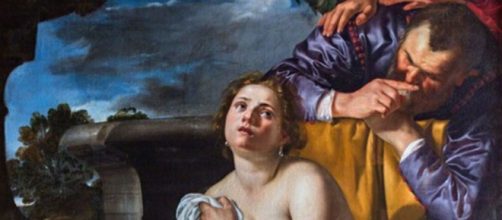Men took a hit in my last column. Not on purpose. History dictated the hit. In today’s piece, men get an “atta boy,” but again not on purpose. History drives this, too.
The first hooray goes to Jonathan Jones, art critic for the British daily The Guardian. His review of the exhibit “Artemisia Gentileschi: The Light in the Shadow” at Burghley House, focused on the way Artemisia depicted sexual predators in the Bible story “Susannah and the Elders.”
As you will see, Jones’ take on Artemisia’s work shows extraordinary compassion for women who are preyed upon.
The artist clearly cared about this subject, too, having painted the tale three times.
Artemisia’s first adaptation – the one most commonly known – came in 1610 when she was 17 years old after she was raped by her art teacher.
Pushing the point
She painted her second version in 1622 at age 29, and the third variation in 1649 when she was 56 years old. Jones singled out the second painting for praise, calling it the kind of work “you should make a pilgrimage to see.”
Compared to Artemisia’s other renditions, Jones says, “there is a punch” with this one, pointing to a detail not seen in the first painting. The Elders are no longer hidden in the bushes. As Jones described them, “they leer openly, intimately, with one making an obscene gesture with his finger.”
He's right to call attention to this detail.
By bringing the Peeping Toms out of the shadows, Artemisia, in effect, caught them with their pants down. The closer look at The Elders doing their dastardly deed made the tale more stinging.
All of which moved Jones to pen the most powerful review I’ve seen him write. “Gentileschi,” he said, “is a hero everyone needs to know about. She’s still fighting her fight: the tear-filled eyes of Susanna.”
All that said, none of it goes to my hooray for Jones. Instead, it’s because he brought into his review a protest sign that appeared outside the U.S. Supreme Court.
The sign pictured Artemisia’s painting set between “two giant menacing hands” under the words, “Hands off Roe v Wade.” Nice going, Jonathan, recognizing that the placard ties a four-century-old work to a current event.
Showing self-awareness
My next "atta boy" goes to Thomas Hart Benton who in 1938 also painted Susannah and the Elders. He gets a bravo because he put himself in the painting as one of the voyeurs.
How extraordinary was this salute to a female painter? Benton is famously quoted in Jo Sprague’s 1943 tome “The Speaker’s Handbook” saying, "An art school is a place for young girls to pass the time between high school and marriage."
My final yay goes to Picasso, who painted the story of Susannah and the Elders in a particularly telling way, too. His way was to picture The Elders in a painting that he hung on a wall behind Susannah.
This arrangement of picture parts comes across like a placard that says, Susannah’s story may be old news, but lechery isn’t.
It’s notable that Picasso painted this work in 1955, the year his first wife Olga Khokhlova – whom he refused a divorce despite his numerous affairs – passed away.
This is not to say there’s necessarily a connection. This is only to say you don’t expect a hard look at lechery to come from a lech.


